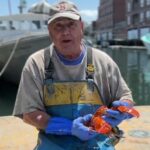Category Archives: Marine Science

‘Two guys are doing all of the work’: Orcas’ inbreeding may devastate the population
Just two male whales fathered more than half the calves born since 1990 in the population of southern-resident killer whales, a sign of inbreeding, scientists have learned. “It was a shocker to find out two guys are doing all of the work,” said Ken Balcomb, director of the Center for Whale Research and an author on a paper published this week in the peer-reviewed scientific journal Animal Conservation. The findings are based on a new genetic analysis of the whales that frequent Washington’s Salish Sea and Puget Sound. >click to read<20:15

Broken down coast guard ship delays spring science survey; DFO’s mismanagement borders on criminal negligence
The Federation of Independent Sea Harvesters of Newfoundland and Labrador (FISH-NL) says the delay of the 2018 multi-species survey in waters off the province because of a broken down science vessel is yet another example of Ottawa’s ongoing gross mismanagement of the fisheries. “Most commercial stocks off our province are in free fall, and the Government of Canada still can’t get the baseline science right,” says Ryan Cleary, President of FISH-NL. >click to read<12:53

Pacific salmon ‘more abundant than ever’, new study claims
Pacific salmon are generally “more abundant than ever.” That is the provocative conclusion of a new paper published in Marine and Coastal Fisheries by Greg Ruggerone of Seattle’s Natural Resources Consultants and James Irvine of the Department of Fisheries and Oceans. The study used historical commercial catch and escapement data for the entire Pacific region for both wild and commercial hatchery salmon over a 90-year period, up to 2015. There is one caveat, however: Ruggerone and Irvine analyzed only data for pink, chum and sockeye salmon. >click to read<09:13
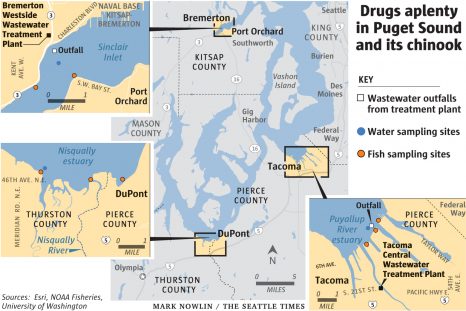
Puget Sound salmon do drugs, which may hurt their survival
Anti-depressants. Diabetes drugs. High-blood-pressure medication. Puget Sound chinook are doing our drugs, and it may be hurting them, new research shows. The metabolic disturbance evident in the fish from human drugs was severe enough that it may result not only in failure to thrive but early mortality and an inability to compete for food and habitat. The research built on earlier work, published in 2016, that showed juvenile Puget Sound chinook and Pacific staghorn sculpin are packing drugs including Prozac, Advil, Benadryl, and Lipitor among dozens of other drugs present in tainted wastewater discharge. >click to read<12:50

Japanese Whaling Fleet Reaches Quota
Japan’s whaling fleet has returned home from the Southern Ocean after a successful 143-day investigation “without being interfered with by the anti-whaling group.” Of the 333 whales killed, 152 were males and 181 were females. A preliminary analysis of pregnancy rate suggests healthy fertility rates, says the Japanese Institute of Cetacean Research. The animals’ earwax plugs and eye lens were used to determine age, blubber was used to determine nutritional status, gonads were used to obtain breeding information and digestive system contents used to examine prey species. >click to read<21:34

“Marine skin” wearable technology tracks underwater creatures
Wearables are normally connected devices like smartwatches or shirts that people wear. Researchers are expanding wearables to cover underwater creatures as well with a new wearable sensor that could help track whale sharks and dolphins in the future. The crab you see here was one of the first test subjects for a new lightweight sensor tag that could track animal movement in deep ocean environments. The sensor is dubbed “Marine Skin” and is designed to be glued to the outer shell or skin of an animal. >click to read<11:42

Russell Wangersky: Fish science still taking a backseat
In science, it’s critically important to compare apples to apples. If you’re looking at comparing data sets, you have to know that you’re using the same comparative parameters, and that all parts of the equation are the same. But that might not be the case for a critical fishery survey being done off Nova Scotia. The coast guard vessel Alfred Needler can’t do the survey, because it’s laid up in the St. John’s shipyard undergoing refit — a refit that has had to be extended after additional work was added. The Teleost, which normally would have done the work if the Needler couldn’t do the five-week trawl survey, is also laid up, and is also behind schedule. >click to read<17:44

Aging coast guard ships stuck in refits put crucial Georges Bank fisheries survey at risk
Once again, Canada’s fleet of coast guard vessels is showing its age. A federal fisheries science survey on Georges Bank is delayed this winter because the Canadian Coast Guard vessel normally tasked with the job is out of commission on an extended refit, CBC News has learned. And a second coast guard ship expected to take over the job is also unavailable because it, too, is undergoing a refit that had to be extended. The five-week Department of Fisheries and Oceans survey off southern Nova Scotia usually starts mid-February aboard the Canadian Coast Guard Ship Alfred Needler, but the 36-year-old vessel is high and dry these days in a St. John’s shipyard. >click to read< 09:40

The phytoplankton decline, is there anything to it?
We have been told that the phytoplankton population is declining rapidly around the world and, of course, the cause is climate change. Phytoplankton is the base of the ocean food chain and it accounts for about half of global primary productivity or organic matter creation (Boyce, Lewis and Worm 2010). Phytoplankton is the major consumer of carbon dioxide, the dreaded demon trace gas, and the major producer of oxygen. So, first question, is the estimated decline in phytoplankton accurate, significant or unusual? Second question, if the decline is real, are the measurements long term enough to show it is not a natural occurrence? What is the natural variability and how do we know man-made climate change is to blame? Let’s investigate this. >click to read< 12:10
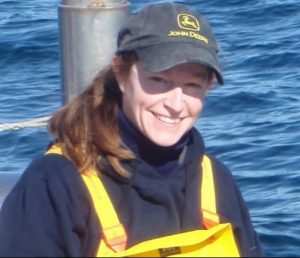
Fisheries scientist takes the spotlight in Fishing Heritage Center’s ‘A Day in the Life’ series
The New Bedford Fishing Heritage Center’s A Day in the Life speaker series continues tonight, March 15, with SMAST fisheries scientist Crista Bank. Beginning at 7 p.m., Bank will share her story and discuss the cooperative research she is currently conducting with the commercial fishing industry. Admission to A Day in the Life is free for Fishing Heritage Center members, and $5 for non-members. The Center is handicap accessible through the parking lot entrance. Free off-street parking available. >click to read<22:33

Ray Hilborn: New study provides no new information on global fishing footprint
University of Washington fisheries researcher Ray Hilborn said that a new study using satellite data from industrial fishing vessels to map global fishing effort fails to provide any new insight, despite media reports indicating otherwise. The study, published in Science in February, used messages transmitted between 2012 and 2016 from the automatic identification systems (AIS) of more than 70,000 industrial fishing vessels to create a global footprint, concluding that “industrial fishing occurs in over 55 percent of ocean area,” according to the abstract. But Hilborn said the vessels monitored for the study were in large part tuna boats over 100 feet, which have been monitored for decades. >click to read< 11:17

Remember when we were told “Penguins Don’t Migrate, they’re dying!” ? – never mind
WUWT readers may remember this story from last year, where Chris Turney, leader of the ill fated “ship of fools” Spirit of Mawson expedition that go stuck in Antarctic sea ice said: “Penguins Don’t Migrate, they’re dying!” and of course blamed the dreaded “climate change” as the reason. Of course three days later, Discover Magazine ran an article that suggested Turney was full of Penguin Poop. Well, seems there’s a surplus of Penguins now, in a place nobody thought to look, there’s an extra 1.5 million Penguins. From Woods Hole Oceanographic Institute. >click to read< 18:03

NMFS Weighing Privately Funded Assessment of Summer Flounder Stock
For the first time, the National Marine Fisheries Service (NMFS) will consider privately funded science in formulating regulations for summer flounder. Funded by the Save the Summer Flounder Fishery Fund (SSFFF) and its contributing partners, a groundbreaking sex-structured model created by Dr. Patrick Sullivan of Cornell University was presented in January to the NMFS’ Stock Assessment Workshop in the hope of obtaining a clearer picture of the summer flounder population. The ultimate goal is to improve the accuracy of the next stock assessment,,, >click to read< 23:14

Study finds tuna fishermen who fish along ocean fronts can significantly boost revenue
These oceanographic conditions are more complex than simply being warmer temperatures, said James Watson, an OSU marine ecologist and lead author on the study. Their technical name is Lagrangian Coherent Structures, though scientists often refer to them as “the skeletons of the sea.”“Essentially they are physical ocean fronts where surface waters converge,” Watson said.,, “What we’ve found is that the stronger the convergence, the more likely it is to attract certain things, beginning with the aggregation of phytoplankton, which in turn attracts larger organisms like tuna – and, ultimately, tuna fishermen.” >click to read<12:25
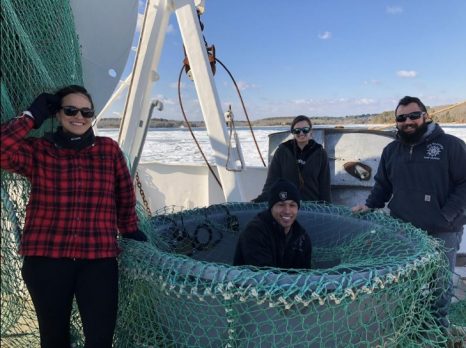
Don Cuddy – SMAST codfish counting innovation looks promising
Last December the New England Fishery Management Council voted to increase the amount of cod available to commercial fishermen in the Gulf of Maine by 39% for the 2018 fishing year. This is welcome news. New England fishermen have endured some lean years since 2013 when the cod quota was slashed by 78 percent after new data incorporated into the 2011 assessment indicated that the stock was lower than previously estimated-obviously a great deal lower. Estimating how many codfish might be out there at any given time is the greatest challenge facing fishery managers and the numbers have been subject of much controversy, with fishermen continually decrying the “best available science” as inadequate. >click to read< 19:25

View to a Kill: Galápagos Sea Lions Team Up to Capture Huge Tuna
In the Pacific, off the Galápagos Islands’ coast, a clever ploy leads to a hearty feast. Sea lions cannot typically catch massive yellowfin tuna—which can swim at speeds of around 40 miles per hour. But a few fishermen recently reported a peculiar hunting behavior among the Galápagos dwellers: Using teamwork, the sea lions have been chasing and trapping the tuna in coves along the archipelago’s ragged coast. Photographer Tui De Roy, a Galápagos resident, recently captured this behavior in a series of striking images. >photo’s, click to read<09:22

Plan details NY state’s vision for offshore wind energy
New York state on Monday released the blueprints for a plan to harness the power of wind through offshore farms.,,, Adrienne Esposito, of Citizens Campaign for the Environment, says the extensive report was long-awaited.,,, “We need to move forward with renewable energy, and stop the oil and gas drilling that is planned for the East Coast.”,,, Bonnie Brady, from the Long Island Commercial Fishing Association, said in a statement to News 12, “Through eminent domain, they are taking away historic fishing grounds and now they are destroying it in the name of green energy. The only green here is about making money.”>click here to read< 10:25
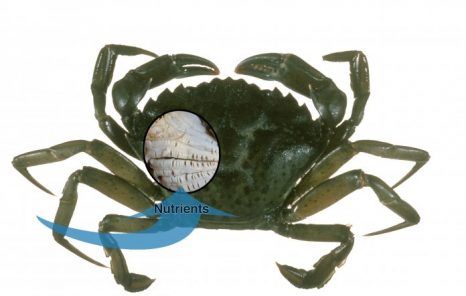
A green crab’s super power: eating through its gills
The phrase “to inhale your food” evokes images of hot dog eating contests or late night fast food binges. But for the European green crab, the phrase is a bit more literal—these crabs can actually absorb food through their gills.,,, Called the shore crab in its native waters around Europe, the European green crab is an invasive species that began wreaking havoc in New England coastal ecosystems following its introduction in the 1800s. It has no predators or competitors and also a killer appetite—crab, fish, young lobster, and shellfish are no match for its nimble, yet crushing claws. >click here to read< 11:27 
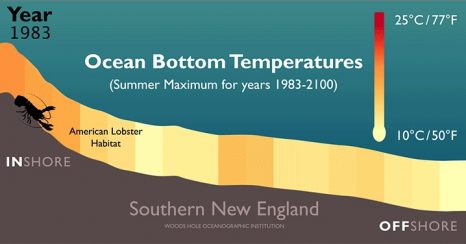
Feeling the Heat in the NW Atlantic
Rising temperatures along the bottom of the Atlantic Ocean will force American lobsters (H. americanus) farther offshore and into more northern waters, according to a new study led by researchers at the Woods Hole Oceanographic Institution (WHOI). Climate models project that bottom temperatures in the Atlantic along the U.S. East Coast may rise by up to 4.3 °C (7.7 °F) by the end of the century. “That’s a significant change, and lobsters are particularly sensitive to warming water temperatures,” says WHOI researcher Jennie Rheuban,, >click here to read< 15:30

P.E.I.’s Western Gulf fishermen excited about highest lobster numbers from survey
There will be more numbers presented at the P.E.I. Fishermen’s Association’s annual meeting in Charlottetown next month, but Francis Morrissey just couldn’t wait that long to share a statistic from Lobster Fishing Area 24. Morrissey, president of the Western Gulf Fishermen’s Association, shared the result from a settlement survey conducted last summer during the group’s annual meeting in Alberton earlier this week. “It was the highest recruitment that was ever recorded any place in Canada or the United States,”,,, >click here to read< 09:10

Science Pushed to Back Burner, as Swiss Outlaw Live Lobster Boiling
Some find it strange, while others, simply fascinating. And others still put it on their dinner menu because they’re drawn to its preparation in a macabre sort of way. But the government of Switzerland believes the practice of throwing a live lobster in a pot of boiling water is unnecessary, and most of all, cruel.,, And this heartfelt legislative decision – presumably not on humanitarian, but lobsterian, grounds – was made Jan. 10. In short, the Swiss simply feared that these tasty, sea creatures experienced agonizing pain during those final, heated moments of their lives. There’s only one problem with that: it’s impossible, since there’s no scientific evidence to support the position. >click here to read< 10:09

The Squid That Sink to the Ocean’s Floor When They Die
While the lives of squid are mysterious in many ways, one gruesome truth is that after mating comes death. First the male dies. Next the female, after making a little pouch of eggs, begins to starve. “She is unable to feed because the egg mass is in front of the mouth,” explains Henk-Jan Hoving, a deep sea biologist at Geomar Helmholtz Centre for Ocean Research in Kiel, Germany. “She probably gets energy from the breakdown of her own tissue, either from the liver or the mental tissue. This is how she stays alive, basically.” Then, once the female is dead and the eggs have hatched, her body will often float to the ocean’s surface and get eaten by birds. >click here to read< 17:43

US review shows pesticides harm threatened salmon, whales
Federal scientists have determined that a family of widely used pesticides poses a threat to dozens of endangered and threatened species, including Pacific salmon, Atlantic sturgeon and Puget Sound orcas. The National Marine Fisheries Service issued its new biological opinion on three organophosphate pesticides — chlorpyrifos, diazinon and malathion — after a yearslong court fight by environmental groups. >click here to read< 19:58 

Inside DFO’s Battle to Downplay a Deadly Farmed Salmon Disease
Part One of a series. Provincial lab played key role in denying existence of HSMI in BC. In 2002, Dr. Ian Keith, a senior DFO veterinarian, began noticing strange heart lesions when he examined Atlantic salmon from B.C.’s growing fish farm industry. Keith was likely the first to detect signs of Heart and Skeletal Muscle Inflammation. The disease, first found three years earlier in Norwegian farmed salmon, went on to plague the industry there, killing up to 20 per cent of salmon in some outbreaks. >click to read the story< 19:21
Part II: DFO’s Plan to Gut Rules Protecting Wild Salmon from Fish Farm Disease – Part two of a series. After court losses, federal government has new strategy to protect industry. >click here to read< 1/11/18 20:29

Potting for cod in a Marlborough Sounds marine reserve
A while back we talked to Tom, a ranger in Akaroa who was working with MPI and NIWA to survey the marine reserves on Banks Peninsula. The survey looked at blue cod numbers in the two marine reserves, with the study allowing DOC to look at the effect those reserves are having on the wider Banks Peninsula fishery.,,, As the boat reached its first stop, the expert skipper flicked on his depth sounder to locate the band of rocky reef and rubble around the island where the crew would lower the first pot. Video, click here to read the story 14:58
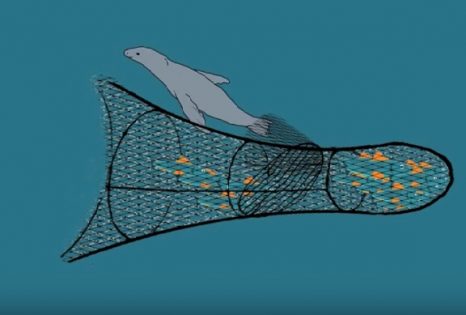
Are Excluder Devices Saving Sea Lions or Covering Up Their Deaths?
A new study blames the fishing industry for the New Zealand sea lion’s decline, but some scientists have doubts.,,, To cut down on collateral damage, some fisheries employ excluder devices, special nets that allow unwanted animals to escape without forfeiting target fish. Australian fishers use seal excluder devices, or SEDs, while turtle excluder devices (TEDs) allow reptiles to pass through American trawls. click here to read the story 11:21
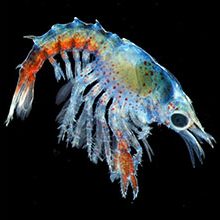
“American lobster larva,” wins people’s choice in Photography category of the 2016 Visualization Challenge
As a master’s student in marine biology at the University of Maine, Jesica Waller spent the summer taking pictures of baby lobsters.,,, This image of a live three-week-old specimen was one of thousands Waller took. It captures the distinct, delicate hairs on the legs. Since lobsters have very poor vision, they rely on their leg hairs for sensory tasks such as finding food. Adults have them too, meaning baby and grown-up lobsters alike taste with their feet. This illustration won people’s choice in the Photography category (click here) of the 2016 Visualization Challenge, now called the Vizzies click here to read the story 18:38

How We Know Megalodon Doesn’t Still Exist?
Megalodon (Carcharocles megalodon) is the largest shark, at a magnificent maximum of 18 meters (59 feet), to ever have dwelled in the oceans. We know primarily about Megalodon’s existence through fossilized teeth. A recent Twitter exchange, made me realize that both some people think Megalodon still exists and a really good write up on how we know Megalodon actually does not exist is not on the interwebs. So in a numbered list, here we go. By Dr. M click here to read the story 19:49

Florida fisherman finds Maryland blue crab
A blue crab was tagged by the Smithsonian in Maryland, and then traveled several years to Florida, where a fisherman recently found it. click here to watch the video. Tagged blue crab caught locally raises eyebrows – When Tom Cochran started crabbing in the Crystal River, he didn’t think he’d make the news. But on Wednesday, Cochran caught a crab he considered noteworthy: one with a tag on it that read “Smithsonian Environmental Research Center.” click here to read the story 09:19





































